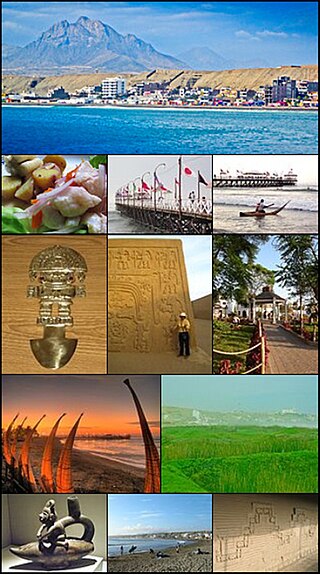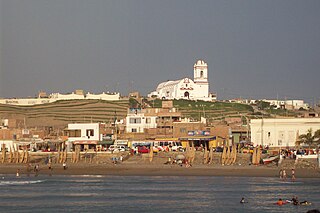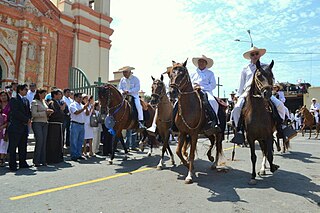- Guaripolas and Queens of Spring in the Paseo de Aguas in Víctor Larco District
- Guaripolas in Trujillo Spring Festival
- Guaripolas in a show
Related Research Articles

The Peruvian Horse is a breed of light saddle horse known for its smooth ride. It is distinguished by a natural, four-beat, lateral gait called the paso llano. This breed is protected by the Peruvian government through Decree number 25919 of Peru enacted on November 28, 1992, and has been declared a Cultural Heritage of the Nation by the National Institute of Culture (INC). Due to the isolation suffered for about 400 years and the selection made by their breeders, this breed is very particular in their body proportions and an ambling gait or "paso llano" that is characteristic. It is typical of the northern Peruvian regions of the country from which it originated. Trujillo city is considered the cradle of typical Peruvian Horses.

Trujillo is a city in coastal northwestern Peru and the capital of the Department of La Libertad. It is the third most populous city and center of the third most populous metropolitan area of Peru. It is located on the banks of the Moche River, near its mouth at the Pacific Ocean, in the Moche Valley. This was a site of the great prehistoric Moche and Chimu cultures before the Inca conquest and subsequent expansion.

La Libertad is a region in northwestern Peru. Formerly it was known as the Department of La Libertad. It is bordered by the Lambayeque, Cajamarca and Amazonas regions on the north, the San Martín Region on the east, the Ancash and Huánuco regions on the south and the Pacific Ocean on the west. Its capital is Trujillo, which is the nation's third biggest city. The region's main port is Salaverry, one of Peru's largest ports. The name of the region is Spanish for "freedom" or "liberty"; it was named in honor of the Intendencia of Trujillo's proclaiming independence from Spain in 1820 and fighting for that. It is the ninth smallest department in Peru, but it is also its second-most populous department after Piura and its second-most densely populated department after Lambayeque.

Huanchaco is a popular seaside resort city in province of Trujillo, Peru. Huanchaco is known for its surf breaks, its caballitos de totora and its ceviche, and is near the ancient ruins of Chan Chan. Huanchaco was approved as a World Surfing Reserve by the organization Save The Waves Coalition in 2012 This historic town is part of the tourist circuit called the "Moche Route" or "Ruta Moche".

Víctor Larco Herrera also called commonly Víctor Larco is a district and a city of the north coast of Peru. It is located on a plain along the Pacific Ocean and is linked by a conurbation with Trujillo in La Libertad region. It is considered one of the 9 districts of the urban area known as Trujillo Metropolitano, one of the most populous metropolitan areas of Peru; it is also one of the 11 districts of Trujillo province. Victor Larco is the district that has the highest human development index (HDI) out of Lima Metropolitana, according to a study published by the United Nations Development Programme. In the early twentieth century, for its mild climate and fresh, it was known as Buenos Aires and then in 1945 got the name of Victor Larco Herrera in memory of the illustrious philanthropist Trujillan who was a benefactor of the city.

A majorette is a baton twirler whose twirling performance is often accompanied by dance, movement, or gymnastics. Majorettes are primarily associated with marching bands during parades. Some majorettes also spin knives, fire knives, flags, light-up batons, fire batons, maces, and rifles. Some also do illusions, cartwheels and flips, and sometimes twirl up to four batons at a time.
Las Delicias is a coastal town located in Moche district, in Trujillo city, La Libertad Region, Peru. It is near the ancient town of Moche. This beach is between Buenos Aires and Salaverry towns.
The Trujillo Spring Festival is a festival and cultural event that takes place in the Peruvian city of Trujillo, between the end of September and beginning of October each year. This spring festival is considered one of the most representative of Trujillo city and honors its nickname of City of the everlasting spring. This festival is also one of the largest in the country and attracts the attendance of thousands of tourists from around the planet. The main attraction of this festival is a traditional Corsican or spring parade, involving mainly beauty queens of Lions clubs across the continent; in the parade there's a competition in the decoration about spring allegory and to be honored with the award called the gold lion. It is organized by the Lions Club of Trujillo.

Trujillo Marinera Festival is a Peruvian cultural event held annually in Trujillo city in January. The event focuses on a dance contest called the marinera, a typical dance of the city and of the country. The festival also presents parades, presentations and competitions of Peruvian paso horses. Both the marinera dance and the Peruvian paso horse have been declared to be part of the cultural heritage of the nation by the Peruvian government. This festival is one of the most important cultural events and representative of the country and Trujillo city has been recognized by the Peruvian government as the National Capital Marinera by Law Number 24447, of January 24, 1986.

San José Festival is a peruvian patronal feast, it is held in the resort called Las Delicias beach in the district of Moche near Trujillo city and the central day is 19 March, the celebrations last a week more or less; these days are of feast and it has been a tradition with a strong Spanish influence, which are enjoyed various activities for adults, youth and children, party hosts are Don Jose and Doña Josefa and Ms Maja, the event begins with the description of characters, activities, bars, flamenco dancing, etc.; This festival is accompanied by a procession of the patron Saint Joseph, the fashion show, the bullfighting, the parade of characters, and toromatch pamplonada in which involved several teams from other regions of the country. Some houses are become in Spanish bars decorated with motifs like flags, grimaldas and posters.

Santiago de Huamán, simply known as Huaman is a traditional village in Trujillo, Peru; it is located in the western part of the city in Víctor Larco Herrera. Currently its main attractions are the Baroque-style church and the Patron Festivities that are held every year in May or June.

Carnival of Huanchaco, is a summer festival held each year in Huanchaco, one of the most visited beaches of Trujillo city, in northern Peru. The carnival is renowned for a lack of alcohol and an early finish. Stories of fire parties on the beach are unfounded. It is organized by the Club Huanchaco, consists of several activities including the crowning of the queen, surf contest, luau party, creativity in the sand, championships of Caballito de totora, the carnival parade among others, by 2012 the carnival parade was held on 25 February.

Lord of Huaman Festival is a patronal feast celebrated every year in the Peruvian town of Santiago de Huamán, in the western part of the city of Trujillo. This Christian celebration has been held for more than 300 years.
Carnival of Conache, is a festival held each year in the peruvian town of Conache, located nearby Trujillo city at southeast. It consists of several activities including the crowning of the queen, and a big celebration with the ancient drink called Chicha.

The International Ballet Festival of Trujillo is an event held in the Peruvian city of Trujillo since 1977. The dancers vary with each event, but over the years participants have come from Chile, Ecuador, El Salvador, France, Mexico, and Germany

Competition of Paso Horses in Trujillo is a contest held in Trujillo city located at northern Peru. These competitions organized by the Association of Breeders and Owners of Paso Horses in La Libertad have as principal participants to the traditional Chalanes (riders) and Peruvian Paso horses in the city are celebrated annually. The care and training of Paso horses in this place is a very old tradition. Trujillo is known and considered as the Cradle of the typical Peruvian Paso Horse as well as the Capital of Culture of Peru so as the Capital of the Marinera dance, which is one of the most important cultural symbols in Peru.

Gastronomic Fair of Trujillo called Sabe a Peru is a gastronomy festival held in the Peruvian city of Trujillo. This festival has been held on 17 and 18 November 2012. It took place in Mall Aventura Plaza Trujillo. In 2012 the festival paid tribute to the "mochero chili" for being an indigenous product, Moche culture legacy. Its historical roots are attractive to encourage experiential tourism in ancestral plots of Trujillo.

The Plazuela El Recreo is a traditional square located in the Peruvian city of Trujillo in La Libertad Region in northern Peru. Situated at the 8th block of the Pizarro street in the Historic Centre of Trujillo in this square are held cultural shows and in March 2012 was the scenery of Trujillo Book Festival. The square has high ficus around. This square has been declared Monumental Heritage of the Nation by the National Institute of Culture of Peru.

Paseo Pizarro is pedestrian walk located on the main street of Trujillo city, in Peru. Pizarro street in blocks 5,6,7 and 8 becomes exclusively a pedestrian and joins the Plaza de Armas with the Plazuela El Recreo, along its four blocks are numerous landmarks like the Palace Iturregui, the Emancipation House, etc. and businesses such as supermarkets, souvenir shops, cafes and bars, etc.
References
- ↑ "Trujillo Capital de la Primavera" (in Spanish). Archived from the original on May 14, 2012. Retrieved September 29, 2012.
- ↑ "Festival de Primavera llega por tercera vez a Moche" (in Spanish). Retrieved September 29, 2012.
- ↑ "Primavera en el penal" (in Spanish). Archived from the original on September 30, 2012. Retrieved September 29, 2012.


